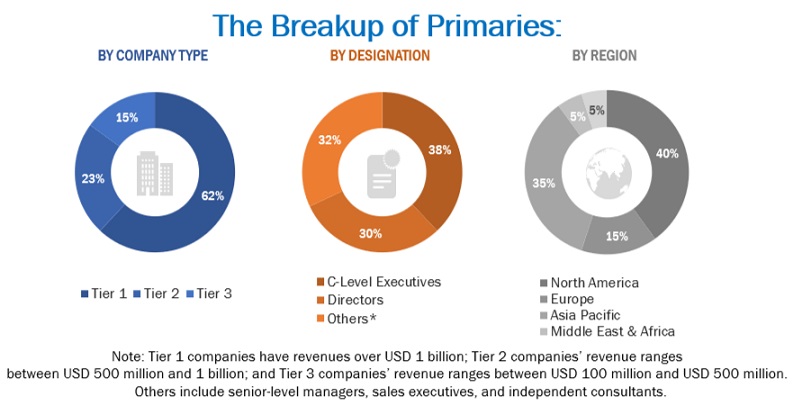The study involved four major activities in estimating the current size of the global next generation emergency response system market. Exhaustive secondary research was done to collect information on the market, peer market, and parent market. The next step was to validate these findings, assumptions, and sizing with industry experts across the value chain through primary research. Both top-down and bottom-up approaches were employed to estimate the total market size of the next generation emergency response system. After that, the market breakup and data triangulation techniques were used to estimate the market size of segments and subsegments.
Secondary Research
In the secondary research process, various secondary sources, such as Bloomberg and BusinessWeek, have been referred to identify and collect information for this study. The secondary sources included annual reports, press releases, and investor presentations of companies; white papers; journals, such as Linux Journal and Container Journal, and articles from recognized authors, directories, and databases.
Primary Research
Various primary sources from both the supply and demand sides were interviewed to obtain qualitative and quantitative information for this report. The primary sources from the supply side included industry experts, such as Chief Executive Officers (CEOs), Chief Marketing Officers (CMO), Vice Presidents (VPs), Managing Directors (MDs), technology and innovation directors, and related key executives from various key companies and organizations operating in the next generation emergency response system market along with the associated service providers, and system integrators operating in the targeted regions. All possible parameters that affect the market covered in this research study have been accounted for, viewed in extensive detail, verified through primary research, and analyzed to get the final quantitative and qualitative data. Following is the breakup of primary respondents.

To know about the assumptions considered for the study, download the pdf brochure
|
Company Name
|
Designation
|
|
Avaya
|
Senior Manager
|
|
Convey 911
|
VP
|
|
Cisco
|
Business Executive
|
Market Size Estimation
For making market estimates and forecasting the next generation emergency response system market, and other dependent submarkets, the top-down and bottom-up approaches were used. The bottom-up procedure was used to arrive at the overall market size of the global next generation emergency response system market using key companies’ revenue and their offerings in the market. The research methodology used to estimate the market size includes the following:
-
The key players in the next generation emergency response system market have been identified through extensive secondary research.
-
The market size, in terms of value, has been determined through primary and secondary research processes.
-
All percentage shares, splits, and breakups have been determined using secondary sources and verified through primary sources.
Next generation emergency response system market Size: Bottom-Up Approach

To know about the assumptions considered for the study, Request for Free Sample Report
Next generation emergency response system market Size: Top-Down Approach

Data Triangulation
With data triangulation and validation through primary interviews, the exact value of the overall parent market size was determined and confirmed using this study. The overall market size was then used in the top-down procedure to estimate the size of other individual markets via percentage splits of the market segmentation.
Market Definition
The next generation emergency response systems market refers to the development, deployment, and maintenance of modernized emergency communication systems that enable faster response times, more accurate call routing, and better coordination during emergencies. These systems are designed to replace the aging analog-based infrastructure with a digital, internet protocol (IP)-based network that can handle a broader range of data, including voice, text, images, and videos.
Key Stakeholders
-
Emergency service providers
-
Technology providers
-
Network operators
-
Research and Development organizations
-
Healthcare providers
-
Law enforcement agencies
-
Non-Governmental Organizations (NGOs)
-
Technology consultants
-
Governments agencies
-
Insurance companies
-
System integrators
-
Telecommunications companies
Report Objectives
-
To determine, segment, and forecast the global next generation emergency response system market based on offering, end user, and region in terms of value.
-
To forecast the size of the market segments to five main regions: North America, Europe, Asia Pacific, Middle East & Africa, and Latin America.
-
To provide detailed information about the major factors (drivers, opportunities, threats, and challenges) influencing the growth of the next generation emergency response system market.
-
To study the complete value chain and related industry segments and perform a value chain analysis of the next generation emergency response system market landscape.
-
To strategically analyze the macro and micro markets to individual growth trends, prospects, and contributions to the total next generation emergency response system market.
-
To analyze the industry trends, patents, and innovations related to the next generation emergency response system market.
-
To analyze the opportunities for stakeholders by identifying the high-growth segments of the next generation emergency response system market.
-
To profile the key players in the market and comprehensively analyze their market share/ranking and core competencies.
-
Track and analyze competitive developments, such as mergers and acquisitions, product launches and developments, partnerships, agreements, collaborations, business expansions, and Research and development (R&D) activities.
Available Customizations
With the given market data, MarketsandMarkets offers customizations as per the company’s specific needs. The following customization options are available for the report:
Company Information
-
Detailed analysis and profiling of an additional two market players



Growth opportunities and latent adjacency in Next Generation Emergency Response System Market